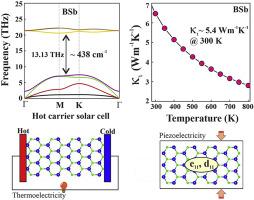Physica E: Low-dimensional Systems and Nanostructures ( IF 2.9 ) Pub Date : 2020-06-11 , DOI: 10.1016/j.physe.2020.114222 Manish Kumar Mohanta , Dimple , Ashima Rawat , Nityasagar Jena , Raihan Ahammed , Abir De Sarkar

|
Recent synthesis of thin films of boron monophosphide (BP) motivates us to report herewith the lattice thermal conductivity calculated in nanoscale boron pnictides. The lattice thermal conductivity in BX (X = P, As, Sb) monolayers are calculated to be 51.3, 20.7 and 5.4 Wm−1K−1 respectively at 300 K. The ultra-low lattice thermal conductivity in BSb, which is comparable to that in SnSe, is attributed to low elastic and bond stiffness, low Debye temperature, small group velocity and large mode Gruneisen parameter near zone center. Phonon group velocities in BSb are comparable to that in SnSe and Bi2Te3. Up to 50% reduction in lattice thermal conductivity is noticed at 300 K upon shortening the phonon mean free path, which is realizable, e.g., in 1D nanoribbons, or via defects, vacancies, nanoengineering, etc. A comparative study based on different models to compute the lattice thermal conductivity will provide useful insights into the experimentally measured ones. The widest ever phononic gap (436 & 438 cm−1) is found in BAs and BSb monolayers, where the transverse and longitudinal optical phonons meet the criterion for the prevention of Klemens decay and hence, they can be gainfully exploited in hot-carrier solar cells. BX (X = P, As, Sb) monolayers show a direct bandgap and piezoelectricity. Nanoscale boron pnictides are promising materials in futuristic thermoelectrics, bolometers, third-generation solar cells and nanopiezotronics.
中文翻译:

多功能纳米级硼化物中巨大声子隙引起的超低热导率和超慢热载体热化
单磷化硼(BP)薄膜的最新合成促使我们在此报告以纳米级硼化物计算的晶格热导率。在BX晶格热导率(X = P,砷,锑)单层计算为51.3,20.7和5.4了Wm -1 ķ -1分别在300K超低晶格热导率在BSb的,这与SnSe中的应力归因于低弹性和粘结刚度,较低的德拜温度,较小的群速度和靠近区域中心的较大模态Gruneisen参数。BSb中的声子群速度与SnSe和Bi 2 Te 3中的声子群速度相当。缩短声子平均自由程后,在300 K时,晶格导热率降低多达50%,这是可以实现的,例如在一维纳米带中,或者通过缺陷,空位,纳米工程等实现。基于不同模型的比较研究计算晶格热导率将提供对实验测量值的有用见解。有史以来最宽的声子间隙(436和438 cm -1)存在于BA和BSb单层中,其中横向和纵向光子满足防止Klemens衰减的标准,因此可以在热载太阳能电池中得到有益的利用。BX(X = P,As,Sb)单层显示出直接的带隙和压电性。纳米级硼化物是未来热电学,辐射热测量仪,第三代太阳能电池和纳米压电的有前途的材料。


















































 京公网安备 11010802027423号
京公网安备 11010802027423号